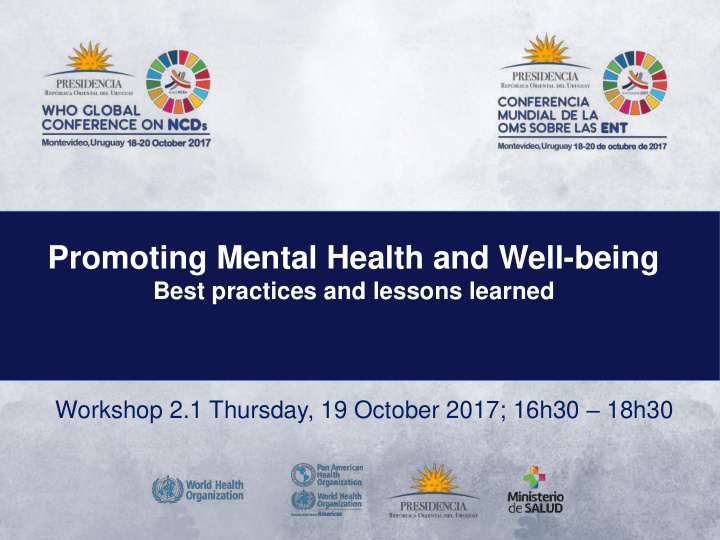



Promoting Mental Health and Well-being Best practices and lessons learned Workshop 2.1 Thursday, 19 October 2017; 16h30 – 18h30
Promoting Mental Health and Well-being Best practices and lessons learned Background: Shekhar Saxena, WHO Workshop 2.1 Thursday, 19 October 2017; 16h30 – 18h30
Mental, l, neurolo logic ical l and su substance use se diso isorders MNS Disorder Prevalent cases % change Number (2005-2015) Schizophrenia 23 million 19% Bipolar disorder 44 million 15% Depression 311 million 18% Anxiety disorders 267 million 15% Alcohol use disorders 63 million 11% Drug use disorders 46 million 16% Dementia 46 million 38% Epilepsy 23 million 11% Source: GBD 2015 study (Vos et al, Lancet 2016; Murray et al, Lancet 2016)
Contribution to overall disease burden YLD DALY Mental and Injuries Mental and substance use 7% substance disorders use disorders CMNN Injuries 19% 7% 12% 11% CMNN 28% Neurological disorders 4% Neurological other NCDs disorders 53% other NCDs 9% 50% Source: GBD 2016 Disease and Injury Incidence and Prevalence Collaborators, Lancet 2017; GBD 2016 DALYs and HALE Collaborators, Lancet 2017
MNS Burden by age 5
Suicide Facts Over 800 000 people die by suicide every year More than deaths by malaria or breast cancer More than in wars, conflicts and disasters Leading cause of death among young adults
Economic burden of mental disorders (Source: WEF and HARVARD, 2011 – The Global Economic burden of NCDs ) Cost of illness- direct and indirect In the year 2010 $ 2,500,000,000,000 In the year 2030 $ 6,000,000,000,000
Burden and Budget: A large Gap
Global health burden versus development assistance in LIC
Return on Investment: Depression treatment Chisholm et al 2016 Investment Return ROI Productivity 2.5 : 1 ($ 230 billion) Investment ($ 91 billion) Value of health 2.8 : 1 ($ 258 billion) Total cost Total benefit 5.3 : 1 ($ 91 billion) ($ 488 billion)
Treatment coverage is low Major Depressive Disorder 51,000 individuals from 21 countries World Mental Health Survey: Thornicroft et al (2016) Minimally adequate treatment Treated Not treated – High income countries: 22.4 % Treated – Middle income countries: Not treated 11.4 % – Low income countries: Treated Not treated 3.7 %
2030 Agenda for Sustainable Development Target 3.4: promote mental health and wellbeing
WHO's Mental Health Action Plan 2013-2020
1 Objectives To strengthen effective leadership and governance for mental health 2 To provide comprehensive, integrated and responsive mental health and social care services in community-based settings 3 To implement strategies for promotion and prevention in mental health 4 To strengthen information systems, evidence and research for mental health
Mental Health Services (WHO, 2003) HIGH LOW Mental Hospitals & Specialist FREQUENCY Services OF NEED COST Community Psychiatri c Mental Services in Health General Services Hospitals Mental Health Services through PHC INFORMAL COMMUNITY CARE LOW HIGH SELF CARE
mhGAP mental health Gap Action Programme Scaling up care for mental, neurological and substance use disorders
mhGAP App Links to additional Clinical Alerts for mhGAP decision critical support information information
Visible examples of WHO significantly contributing to building mental health systems in/after emergencies Guinea Liberia Indonesia Sri Lanka Jordan Syria Kosovo Turkey Lebanon West Bank and Gaza Strip
Depression: le let's talk lk A campaig ign for r us s all ll
Much more to be done….. • Integration within health system • Enhanced financing for mental health • Increasing trained human resources • Improving human rights • Involving people with mental disorders Innovation is the key !
Recommend
More recommend